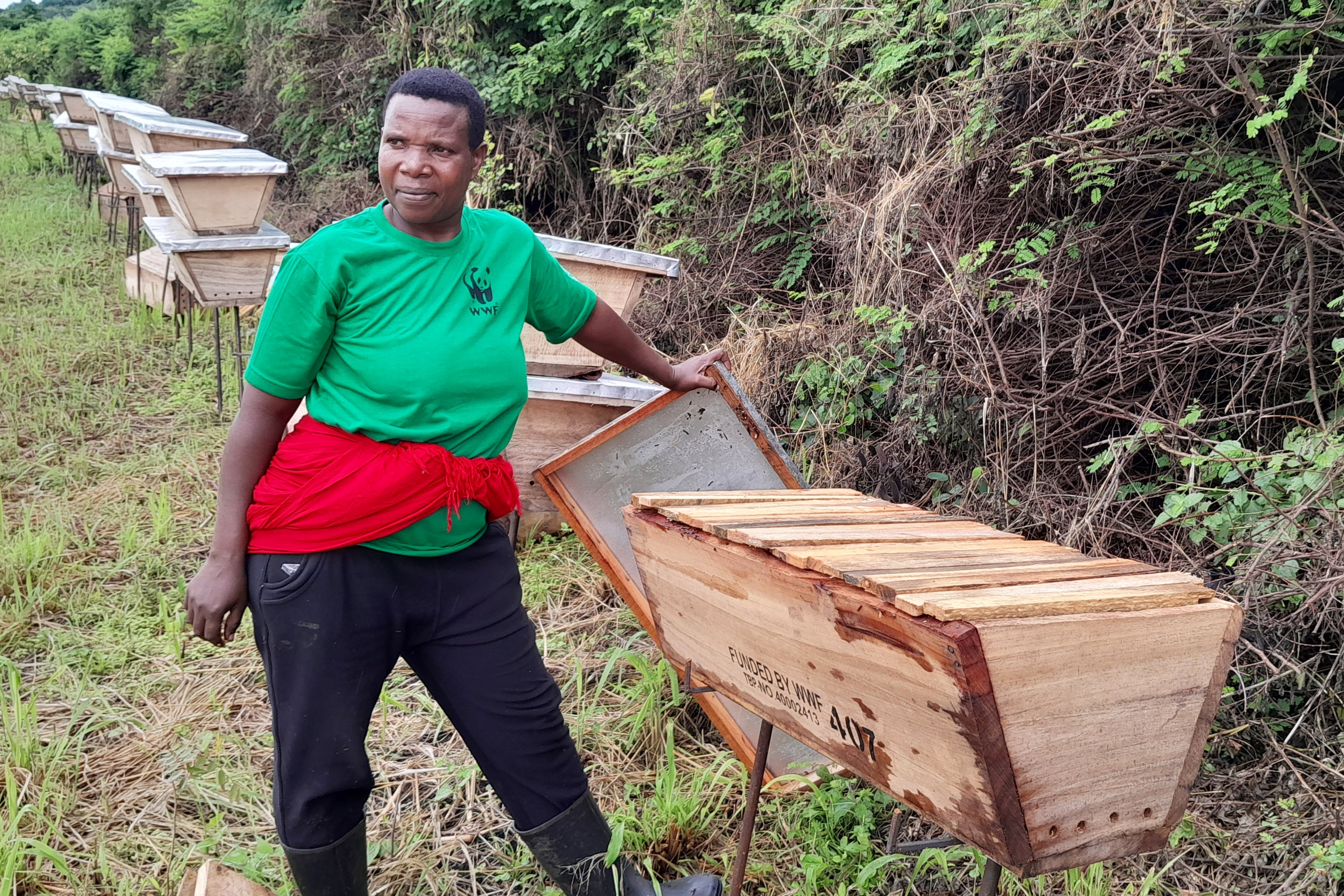Prime
How beehive fencing is countering human-wildlife conflict in Rubirizi

Tumwebaze, one of the people spearheading the project, checks out the beehive fence at the border with Queen Elizabeth National Park. PHOTO/ZADOCK AMANYISA
What you need to know:
- Until 2,000s, residents in Rubirizi District were hit the hardest by wildlife-human conflict. Family heads died and crops were destroyed. Beehive fencing keeps elephants at bay and boosts income of residents.
It is 8am and it is already scorching hot along the sharp escarpment of the western arm of the East African Rift Valley in Rubirizi District.
Although it is a dry season, the steep footpath cutting across the escarpment is very slippery. You need rocky boots and a walking stick to make it to the border between Queen Elizabeth National Park and the Kataara Community, where conflict between elephants and residents has reigned.
Four of us are walking down the slope and we are led by Immaculate Tumwebaze, the chairperson of Kataara Women Poverty Alleviation Group (KWPAG), in Kataara one village, Kicwamba Sub-county.
This group of reformed poachers has been at the centre of human-elephant conflict resolution initiatives. Plains that stretch from the rift valley to Lake Edward are a sight to behold.
We find Elius Muhirehi, a cassava farmer, weeding his garden, and our aim of visiting that area is made known to him. We are here to make sense of the struggles of residents here.
“Guarding our gardens against elephants has become an extreme sport. Last night, they ate and trampled over our crops. Many people in this community, lost their lives in this struggle, but we thank God for sparing us,” says Muhirehi.
Until 2,000s, residents in Rubirizi District were hit the hardest by the wildlife-human conflict. Family heads who went to the national park to take revenge on wild animals, met their deaths.
They were killed by animals and park rangers. Thanks to the different interventions that came through on how communities can benefit from the park.
Alternative sources of livelihoods included coffee farming, the making of paper from elephant dung, and later bee keeping, which acts as a fence and has been proven to be a long lasting nature-based solution to the conflict.
Yes, bees are smaller than men, but they are successful in repelling these giant animals. Bees sting the elephants and scare them away, thus saving their crops.
Why the conflict?
For hundreds of years, elephants have coexisted with communities. It is the boundaries, human activities and competition for natural resources that have intensified pressure between man and elephants.
Naturally, elephants are herbivores, eating up to 150 kilogrammes of fodder and drinking up to 190 litres of water, per day. This is why they have to traverse large spaces, in search for food and water in order to survive. But the land they are surviving on is under pressure from human beings.
Most times, it is the competition for space that breeds conflict because elephants know no boundaries. They find their space occupied with farms and settlements, as man also claims ownership of the same space.
How beehive fencing works
According to Tumwebaze, the Chairperson of KWPAG, a group that is spearheading the alternative method, says bees are helping them avert the elephant-human conflict management.
“We line up beehives along the border in form of a fence. Once these beehives have been colonised by bees and elephants attempt to cross, bees swarm out, sting them in sensitive parts, and chase them away. Elephants fear bees,” she explains.
When they are stung in the eyes, trunks, and ears by the buzzing honey bees, the gentle giants of the park redirect their movements. This method comes in handy on top of other interventions such as live electric wire fencing, trench excavation, and others.
Tumwebaze says beehive fencing comes with other benefits such as boosing their income through honey and wax harvesting. Although they are not labour-intensive, she says the hives need constant monitoring.
“The hives are wooden and we erect them on wooden stands, because we cannot afford metallic ones. We keep checking and clearing the bush to keep snakes away. Snakes like honey. Honey is our source of livelihood,” she says.
“Elephants no longer destroy our crops and residents are making some money from honey and wax. I personally use the money to take my siblings to school,” says Leticia Nayebare, a member of the group.
The difference it makes
A Uganda Wildlife Authority (UWA) and Mountains of the Moon University-led bivariate analysis conducted in 2020, on the magnitude of destruction in areas of Kataara A, Kataara B, Kyansama A, and Kyansama B, proved that beehive fencing can perform better.
The study indicates that where there was beehive fencing, 15 cases (1.7 percent) of crop damage were recorded, while places without beehives, recorded 846 (98.8 percent) cases.
Human injury was at 3.8 percent, with one case in areas with beehives and 25 (96.2 percent) cases in areas without beehives. There was no livestock predation case recorded in areas with beehive fencing.
John Tugume, the UWA official in charge of Kyambura Game Reserve, says the project was first supported by UWA, but the resources were not enough to cover the whole area. World Wide Fund (WWF) is supporting residents with hundreds of beehives.
“We continue to offer guidance to ensure the project becomes a success. Research shows that beehives can control human-elephant conflict at a level of 80 percent. It has proven that it improve livelihoods. If we are supported, this conflict will become history,” he says.
Geoffrey Muhindo, a senior entomologist in Rubirizi, says the district is training residents on proper handling of bees. He says farmers have the potential to produce up to 40 tonnes of honey in a year.
Having covered three kilometres, according to Tugume, more support is needed to cover the whole stretch of more than 10 kilometres.
Moses Agaba, the coordinator of KWPAG, however, fears the project may suffer sustainability issues and appeals to government to lend a hand.
“We do not have enough beehives and metallic stands for our beehives since the wooden ones are not as strong. They quickly rot away. We do not have money to get ourselves metallic stands. We request the government to support our interventions,” says Agaba.
200 beehives in Mitooma
UWA has earmarked a supply of more than 200 beehives in Mitooma District as a short-term intervention to facilitate coexistence. The intervention has worked in Kibaale National Park, where more than 1,500 beehives were installed, according to George Owoyesigire, the acting commissioner for wildlife conservation in the Ministry of Tourism.
The International Fund for Animal Welfare (IFAW), a global group helping animals and people thrive together, describes human-elephant conflict as “negative interactions between man and elephants, with most forms being crop raiding and property destruction, in which people get too close to elephants, triggering defensive behaviours that may lead to injury or death of people and elephants.
Study
A Uganda Wildlife Authority (UWA) and Mountains of the Moon University-led bivariate analysis conducted in 2020, on the magnitude of destruction in areas of Kataara A, Kataara B, Kyansama A, and Kyansama B, proved that beehive fencing can perform better.
The study indicates that where there was beehive fencing, 15 cases (1.7 percent) of crop damage were recorded, while places without beehives, recorded 846 (98.8 percent) cases.





